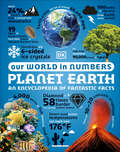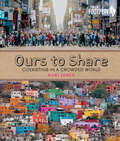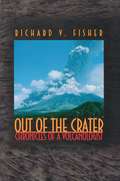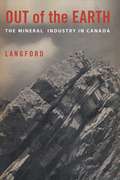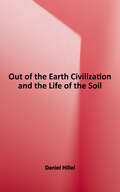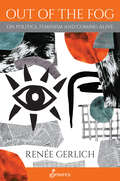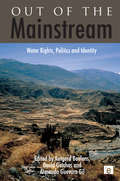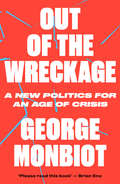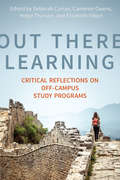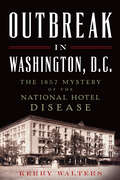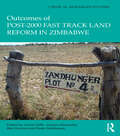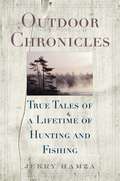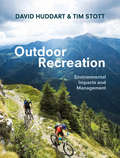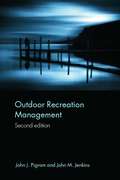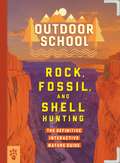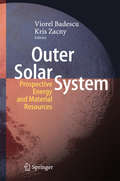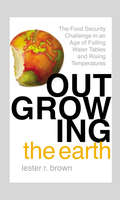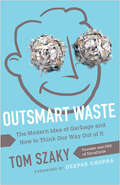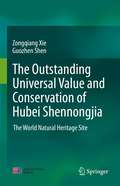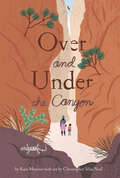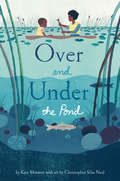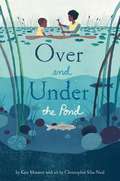- Table View
- List View
Our World (Environmental Studies) Semester - 2 class 5 - Andhra Pradesh Board
by State Council of Educational Research and Training Andhra PradeshThe Class 5 Environmental Studies Semester 2 textbook, titled "Our World", is designed to foster an understanding and appreciation of the environment among young learners. Published by the Government of Andhra Pradesh under the Samagra Shiksha initiative, the book features a bilingual approach to make learning accessible. It covers themes like family, nature, safety, governance, and the Indian freedom struggle, integrating real-life scenarios and hands-on activities. Each chapter includes colorful illustrations, QR codes for enhanced learning, and a variety of activities to promote critical thinking, creativity, and engagement. The book aligns with global educational standards and emphasizes foundational concepts, scientific temper, and values such as kindness and teamwork. Special features include learning outcomes, key terms, and summaries to reinforce concepts. Designed with inputs from educational experts, the textbook aims to cultivate environmental awareness, civic responsibility, and academic skills in students.
Our World in Numbers: Planet Earth (DK Oour World in Numbers)
by DKLearn about everything on planet Earth with this book of extraordinary figures and number-based facts for children aged 9-12!Put the fun back into learning and take children on a number-crunching journey around our incredible planet. From microscopic minerals to majestic mountains and everything in between, learn all about planet Earth with more than 1,000 weird and wonderful numbers.Our World in Numbers: Planet Earth will have you impressing your family and friends like never before with mind-blowing figures behind rising sea levels, the gradual growth of mountains, and wild weathers. Children aged 9-12 will number-crunch their way around the planet, discovering everything about world's biggest oceans, rivers, and mountains.This Earth book of fantastic figures offers:More than 1,000 astonishing Earth facts for children aged 9-12.Different topics divided by 5 chapters that explore the planet.Eye-catching double page features, including vibrant photographs and graphics for every topic.Fun and surprising information on more than 80 topics to engage children in the world around them.This data-packed adventure through the animal world is filled with everything you’ve ever wanted to know about the planet, with full-page photographs and fun, colorful images, wacky fact-bites, and funky figures to become an animal expert! More in the seriesOur World in Numbers explores figures and number-based facts through exciting topics, vibrant photos and exciting graphics. If you liked Our World in Numbers: Planet Earth, why not try Our World in Numbers: Animals, and learn about the animal kingdom, or Our World in Numbers: Dinosaurs, and discover the prehistoric world.
Ours to Share: Coexisting in a Crowded World (Orca Footprints #16)
by Kari JonesThere are almost eight billion people alive today. Having that many people in the world puts pressure on both social and natural resources, and we have to ask ourselves difficult questions like, What is our fair share? And how do we share more equitably? Ours to Share starts by giving an overview of human population growth, from the time when there were only a few hundred thousand people until now. The book goes on to examine some of the inequities that happen between people when natural and social resources are stressed and provides examples of people who have found innovative ways to share more equitably with their neighbors. The book also examines the impact our expanding population has had on other species. Finally, the book offers suggestions for actions kids can take to better the world from their own home, school and community. The epub edition of this title is fully accessible.
Out of the Crater: Chronicles of a Volcanologist
by Richard V. FisherVolcanologists venture to treacherous volcanoes the world over in the pursuit of their science. They work around craters of boiling magma and amidst smoke, flames, scorched rocks, and clouds of noxious gases--balancing personal risk against advancing knowledge about one of nature's most dangerous and unpredictable forces. Richard Fisher, a world-renowned volcanologist, has had more than forty years of experience in the field. In this book, he blends autobiography with clear, accessible science to introduce readers to the basics of volcanology and to the wonders of volcanoes that he has studied and learned to both fear and admire. In the course of the book, we follow Fisher as he descends into the steaming crater of the Soufri re Volcano on the island of St. Vincent, as he conducts research on lava flows on the desolate south shore of the Island of Hawaii, and as he struggles to understand the explosion at Mount St. Helens. We learn about his pioneering work on pyroclastic flows and surges--the hurricanes of gases, molten lava, and volcanic debris that cause most of the death and destruction when volcanoes explode. He tells of solving a historic scientific problem at Mount Pelee, Martinique, where 29,000 people were killed in a pyroclastic flow in 1902. Fisher also offers a volcanologist's view of the explosion of Mount Vesuvius that devastated Pompeii and Herculaneum. He writes about the cultural rewards and challenges of conducting research in isolated areas of such countries as Argentina, Mexico, and China. And he discusses the early influences that steered him toward volcanology--including his army experiences as a witness to two atom-bomb explosions at Bikini atoll. Out of the Crater is written in an inviting, nontechnical style. With its deft combination of personal stories and scientific information, it is an inspiring account of a remarkable life and a compelling examination of some of the most spectacular forces shaping the face of the Earth.
Out of the Earth: The Mineral Industry in Canada
by G. B. Langford<p>OUT of the Canadian earth come treasures right and rare--gold, silver, uranium. Out of the earth come the raw materials of the industry--iron,copper, nickel, and the like. From deep in the earth flows the petroleum that keeps the wheels moving in our modern economy. Coal for our fires lies under the soil of Canadian prairies, mountains, and coastal seas. From the earth comes the building materials for towns and cities, roads, and bridges. From the earth come the glass and dishes for our homes, the salt for our tables, and the nylons we wear. Every Canadian uses the products of our mines. Many persons are employed in the mining industry, or in the multitude of industries dependent on its products. Many Canadians are investors in the industry, buying shares in mining companies, or processing industries, or the enterprises that sell mineral products to the public. <p>This book is the direct result of the desire expressed by Canadians in many walks ofl ife to know "more about mining." It takes the interested layman on a short trip through the complex mining industry. It describes, very clearly and readably, how the minerals were formed int he earth, how they are found, how they are taken out of the earth, and how the ores are processed and the petroleum transformed to high grade gasoline. It goes farther, telling how a mine is financed, how the prospector, the engineer, the government, the mine operator, financier, and investor combine to make the great Canadian mineral industry what it is. It tells, too, about the "jobs" in the industry--about the opportunities for geologists, geophysicists, engineers, production and physical metallurgists, and many other professions that young Canadians find both challenging and rewarding. This book gives the clue to the "language" of the mining industry--"conglomerate," "stope," "spudding in," "repressuring," "working option," "reorganization," "speculative risk"--to name only a few terms that are read on the financial page every day, and which the intelligent investory wants to understand clearly. <p>Out of the Earth tells about mining as it is today. We meet not just the propector carrying his pick, but the airborne magenetometer, which detects mineral deposits from the sky. Most readers have heard of the use of Geiger counters in locating radioactive substances, but here we read also, for example, about the seismic methods of mineral exploration, by which dynamite is fired in the earth and the shock-wave patterns calculated on instruments.Helping to make important points of the story clear are simple tables and 40 excellent line-drawings and charts. A group of photographs, chosen for informational value as well as pictorial interest, is included.</p>
Out of the Earth: Civilization and the Life of the Soil
by Daniel HillelAs the crucible of life, the source and final resting place of everything that grows, soil inspires reverence in the peasant and the scientist. This title presents the history of man's use and misuse of soil and water. It combines a description of the inner processes that form soil with an assertion of its powers and significance.
Out of the Fog: On Politics, Feminism and Coming Alive
by Renée Gerlich...understanding how our private heartbreak relates to our large-scale problems is the only way we can unravel the helplessness we feel, claim our voices, and take action in the way we deeply crave. We cannot do any of these things while living with the cognitive dissonance of competing ideas, priorities, solutions, and top-down paternalism.From racialised police brutality to climate change, #MeToo, ‘ trans rights' , COVID-19, the prospect of nuclear war and the prevalence of trauma – we are constantly bombarded with high stakes problems that we are expected to speak out about and act on. On closer inspection, the popular solutions to each of these problems aren' t easy to reconcile. Black Lives Matter activists demand prison abolition, while #MeToo feminists want rapists in jail – and while our objections to war and police brutality make us suspicious of state institutions in general, our responses to climate change and COVID-19 reinforce our dependency on them.Out of the Fog cuts through the confusion. René e Gerlich suggests that readers move beyond feeling overwhelmed and emotionally manipulated. She draws on a radical feminist tradition that demonstrates how our despair is connected to our most pressing social problems, and offers a framework for assessing and interpreting the current political landscape. Out of the Fog delivers clarity and guidance in this bewildering time. René e Gerlich' s insights will help you develop the capacity to speak with an authentic voice and to act purposefully and with impact in the world.
Out of the Mainstream: Water Rights, Politics and Identity
by Rutgerd Boelens David Getches Armando Guevara-GilWater is not only a source of life and culture. It is also a source of power, conflicting interests and identity battles. Rights to materially access, culturally organize and politically control water resources are poorly understood by mainstream scientific approaches and hardly addressed by current normative frameworks. These issues become even more challenging when law and policy-makers and dominant power groups try to grasp, contain and handle them in multicultural societies. The struggles over the uses, meanings and appropriation of water are especially well-illustrated in Andean communities and local water systems of Peru, Chile, Ecuador, and Bolivia, as well as in Native American communities in south-western USA. The problem is that throughout history, these nation-states have attempted to 'civilize' and bring into the mainstream the different cultures and peoples within their borders instead of understanding 'context' and harnessing the strengths and potentials of diversity. This book examines the multi-scale struggles for cultural justice and socio-economic re-distribution that arise as Latin American communities and user federations seek access to water resources and decision-making power regarding their control and management. It is set in the dynamic context of unequal, globalizing power relations, politics of scale and identity, environmental encroachment and the increasing presence of extractive industries that are creating additional pressures on local livelihoods. While much of the focus of the book is on the Andean Region, a number of comparative chapters are also included. These address issues such as water rights and defence strategies in neighbouring countries and those of Native American people in the southern USA, as well as state reform and multi-culturalism across Latin and Native America and the use of international standards in struggles for indigenous water rights. This book shows that, against all odds, people are actively contesting neoliberal globalization and water power plays. In doing so, they construct new, hybrid water rights systems, livelihoods, cultures and hydro-political networks, and dynamically challenge the mainstream powers and politics.
Out of the Woods: A True Story of an Unforgettable Event (Into Reading, Read Aloud Module 9 #3)
by Rebecca BondNIMAC-sourced textbook
Out of the Wreckage: A New Politics for an Age of Crisis
by George MonbiotA thrilling new route to a better societyA toxic ideology of extreme competition and individualism has come to dominate our world. It misrepresents human nature, destroying hope and common purpose. Only a positive vision can replace it, a new story that re-engages people in politics and lights a path to a better future.George Monbiot shows how new findings in psychology, neuroscience and evolutionary biology cast human nature in a radically different light: as the supreme altruists and cooperators. He shows how we can build on these findings to create a new politics: a “politics of belonging.” Both democracy and economic life can be radically reorganized from the bottom up, enabling us to take back control and overthrow the forces that have thwarted our ambitions for a better society.Urgent and passionate, Out of the Wreckage provides the hope and clarity required to change the world.
Out There Learning: Critical Reflections on Off-Campus Study Programs
by Deborah Louise Curran Cameron Owens Helga Thorson Elizabeth VibertUniversities across North America and beyond are experiencing growing demand for off-campus, experiential learning. Exploring the foundations of what it means to learn "out there," Out There Learning is an informed, critical investigation of the pedagogical philosophies and practices involved in short-term, off-campus programs or field courses. Bringing together contributors’ individual research and experience teaching or administering off-campus study programs, Out There Learning examines and challenges common assumptions about pedagogy, place, and personal transformation, while also providing experience-based insights and advice for getting the most out of faculty-led field courses. Divided into three sections that investigate aspects of pedagogy, ethics of place, and course and program assessment, this collection offers "voices from the field" highlighting the experiences of faculty members, students, teaching assistants, and community members engaged in every aspect of an off-campus study programs. Several chapters examine study programs in the traditional territories of Indigenous communities and in the Global South. Containing an appendix highlighting some examples of off-campus study programs, Out There Learning offers new pathways for faculty, staff, and college and university administrators interested in enriching the experience of non-traditional avenues of study.
Outbreak in Washington, D. C.: the 1857 Mystery of the National Hotel Disease (Disaster Ser.)
by Kerry WaltersAn account of the mysterious epidemic among nineteenth-century hotel guests that &“enthralled the country and nearly took the life of the-President-elect&”(The Washington Post). The National was once the grandest hotel in the capital. In 1857, it twice hosted President-elect James Buchanan and his advisors, and on both occasions, most of the party was quickly stricken by an acute illness. Over the course of several months, hundreds fell ill, and over thirty died from what became known as the National Hotel disease. Buchanan barely recovered enough to give his inauguration speech. Rumors ran rampant across the city and the nation. Some claimed that the illness was born of a sewage &“effluvia,&” while others darkly speculated about an assassination attempt by either abolitionists or southern slaveowners intent on war. In this concise and captivating account of the events—as well as the panic and rumors surrounding them—Kerry Walters investigates the mysteries of the National Hotel disease.
Outcomes of post-2000 Fast Track Land Reform in Zimbabwe (Critical Agrarian Studies)
by Lionel Cliffe Jocelyn Alexander Ben Cousins Rudo GaidzanwaThe struggle over land has been the central issue in Zimbabwe ever since white settlers began to carve out large farms over a century ago. Their monopolisation of the better-watered half of the land was the focus of the African war of liberation war, and was partially modified following Independence in 1980. A dramatic further episode in this history was launched at the start of the last decade with the occupation of many farms by groups of African veterans of the liberation struggle and their supporters, which was then institutionalised by legislation to take over most of the large commercial farms for sub-division.Sustained fieldwork over the intervening years, by teams of scholars and experts, and by individual researchers is now generating an array of evidence-based findings of the outcomes: how land was acquired and disposed of; how it has been used; how far new farmers have carved out new livelihoods and viable new communities; the major political and economic problems they and other stakeholders such as former farm-workers, commercial farmers, and the overall rural society now face.This book will be an essential starting place for analysts, policy-makers, historians and activists seeking to understand what has happened and to spotlight the key issues for the next decade.This book was published as a special issue of the Journal of Peasant Studies.
Outdoor Chronicles: True Tales of a Lifetime of Hunting and Fishing
by Jerry Hamza Joseph B. HealyWe hold a great affection for the deep tradition of American storytelling. The ability to spin a yarn that can hold our attention and provide a gentle direction for life is something that has been with us for a long time. "The Celebrated Jumping Frog of Calaveras County” by Mark Twain or Ernest Hemingway’s Nick Adams stories hold us with their gentle wit and carry us away for just a little while. In Outdoor Chronicles, Jerry Hamza takes up the gauntlet of the storyteller to take readers away for a little fun. There are already plenty of how-to fishing and outdoor books, and this is not one. Hamza’s stories will not make you a better caster or shooter, but they will make you want to spend more time fishing or hunting.This book is a collection of outdoor stories wrapped in the human condition. They were written with an eye toward honesty and cynicism. They will make you laugh out loud, and you will want to carry them with you wherever you go. If this book goes missing, it’s a sure thing that, when you do find it, it will be in the possession of a member of your household, regardless of their interest in casting a fly. The stories cover the gamut from a fishing trip to northern Canada to a little stream that was actually better than remembered, to how the baby boomers almost trampled a sport to death, to a solitary trek along railroad tracks during a cold, dark, and dreary February, and many more.Skyhorse Publishing is proud to publish a broad range of books for hunters and firearms enthusiasts. We publish books about shotguns, rifles, handguns, target shooting, gun collecting, self-defense, archery, ammunition, knives, gunsmithing, gun repair, and wilderness survival. We publish books on deer hunting, big game hunting, small game hunting, wing shooting, turkey hunting, deer stands, duck blinds, bowhunting, wing shooting, hunting dogs, and more. While not every title we publish becomes a New York Times bestseller or a national bestseller, we are committed to publishing books on subjects that are sometimes overlooked by other publishers and to authors whose work might not otherwise find a home.
Outdoor Recreation: Environmental Impacts and Management
by David Huddart Tim StottThis textbook presents a comprehensive overview of the environmental impacts of various types of outdoor recreation, and how these can be best managed. As a field of study, recreational ecology is both multidisciplinary and interdisciplinary, and the authors seek to develop a deeper understanding of both the role and function of the factors that influence visitor numbers and their impact. An accessible and comprehensive textbook, it features numerous types of outdoor recreational activities including hill walking, rock climbing, mountain marathons, skiing, scuba diving and more.Drawn from several global case studies, the authors estimate the current and future numbers involved in outdoor recreation, and how best these numbers can be managed. Effective visitor impact management actions arise from collaboration between recreation ecologists, social scientists, experienced recreation managers, recreation stakeholders and the recreationalists themselves: as such, this book will be multi-disciplinary in scope. This practical and engaging textbook will be invaluable to students and scholars of outdoor recreation and adventure tourism as well as practitioners and managers working in the field.
Outdoor Recreation Management (Routledge Advances in Tourism)
by John Jenkins John PigramIt is now widely recognized that recreation is as important as work. This revealing book analyzes leisure and outdoor recreation in terms of both their management and their wider importance to society. Specifically, it: clarifies the link between leisure, recreation, tourism and resource management reviews contemporary outdoor recreation management and concepts critically examines approaches to outdoor recreation planning and management in diverse recreational settings considers the future of outdoor recreation and the potential influences of economic, social, political and technological developments. Wide-ranging and topical, it considers such issues as motivation and choice, provision for people with special needs, the impact of outdoor recreation on the environment, and outdoor recreation in both urban and rural contexts. This comprehensively revised second edition has many sections rewritten and expanded to reflect contemporary development in leisure and outdoor recreation management in countries such as Australia, Canada, the UK, the US and New Zealand. With an extensive bibliography of more than 500 references and including further reading sections and review questions, it is an essential student purchase and one of the most comprehensive and international accounts of outdoor recreation management available.
Outdoor School: The Definitive Interactive Nature Guide (Outdoor School)
by Jennifer SwansonRewild your life! With metal corners and 448 full-color, highly illustrated pages, OUTDOOR SCHOOL: ROCK, FOSSIL, AND SHELL HUNTING is an indispensable tool for young explorers and rock collectors.Make every day an adventure with the included:- Immersive activities to get you exploring- Write-in sections to journal about experiences- Next-level adventures to challenge even seasoned nature loversNo experience is required—only curiosity and courage. This interactive field guide to rocks, fossils & shells includes:- Digging, chiseling, hammering, and wading for rocks and minerals- Identifying rocks & minerals by location, texture, color, shape, and size- Determining between rocks, geodes, and space rocks- Finding fossils and setting up a dig site- Searching and snorkeling for shells- Storing and displaying your collectionAnd so much more!
Outer Banks Shipwrecks: Graveyard of the Atlantic (Images of America)
by Mary Ellen RiddleEver since ships began navigating the coast of North Carolina, the area has maintained a reputation for being dangerous. Today, the region that stretches from the Currituck Outer Banks south to Bogue Banks is referred to as the “Graveyard of the Atlantic.” From the 1585 grounding of the English ship Tiger off the Outer Banks to the 2012 loss of the Bounty, more than 2,000 shipwrecks have occurred in the Graveyard of the Atlantic. Weather, geography, war, piracy, and human error have all contributed to this dense shipwreck zone. The stories behind the shipwrecks illustrate the best and worst of mankind, showing courage and compassion as well as the atrocities of war. This history informs readers about commerce, technology, war, environment, maritime life, and the complexity of the human element.
Outer Solar System: Prospective Energy And Material Resources
by Viorel Badescu Kris ZacnyThe Earth has limited resources while the resources in space are virtually unlimited. Further development of humanity will require going beyond our planet and exploring of extraterrestrial bodies and their resources. This book investigates Outer Solar Systems and their prospective energy and material resources. It presents past missions and future technologies and solutions to old problems that could become reality in our life time. The book therefore is a great resource of condensed information for specialists interested in current and impending Outer Solar Systems related activities and a good starting point for space researchers, inventors, technologists and potential investors.
Outgrowing the Earth: The Food Security Challenge in an Age of Falling Water Tables and Rising Temperatures
by Lester R. BrownHistorically, food security was the responsibility of ministries of agriculture but today that has changed: decisions made in ministries of energy may instead have the greatest effect on the food situation. Recent research reporting that a one degree Celsius rise in temperature can reduce grain yields by 10 per cent means that energy policy is now directly affecting crop production. Agriculture is a water-intensive activity and, while public attention has focused on oil depletion, it is aquifer depletion that poses the more serious threat. There are substitutes for oil, but none for water and the link between our fossil fuel addiction, climate change and food security is now clear. While population growth has slowed over the past three decades, we are still adding 76 million people per year. In a world where the historical rise in land productivity has slowed by half since 1990, eradicating hunger may depend as much on family planners as on farmers. The bottom line is that future food security depends not only on efforts within agriculture but also on energy policies that stabilize climate, a worldwide effort to raise water productivity, the evolution of land-efficient transport systems, and population policies that seek a humane balance between population and food. Outgrowing the Earth advances our thinking on food security issues that the world will be wrestling with for years to come.
Outsmart Waste: The Modern Idea of Garbage and How to Think Our Way Out of It
by Tom SzakyGarbage has become a huge problem. Ever-expanding hazardous landfills, toxic waste dumps, ocean dead zones, endangered wildlife--it's an environmental nightmare. But garbage is a recent problem--for most of human history it was a minor annoyance--so we should be able to solve it. And garbage doesn't even exist in nature, where the output of one organism is the input of another. So why does garbage exist in human society? Why has it become a problem only in the last century? And most importantly, how can we eliminate it--outsmart the very idea of garbage? Eco-entrepreneur Tom Szaky says that to outsmart waste, first we have to understand it, then change how we create it, and finally rethink what we do with it. He traces the roots of our current garbage crisis to 20th-century social shifts and technological advances that resulted in historic changes in consuming habits--both the amount of garbage created and its longevity increased dramatically. We are now producing five billion tons of waste a year, and our only ways of dealing with it are crude and even dangerous: burying it or burning it. We can do better! Every time we make a purchase, we are essentially voting for the kind of world we want to live in. Szaky shows that by becoming acutely aware of the deeper implications of why we buy, what we buy, when we buy, and what we do with what we've bought, we can cast our vote for a waste-free world. And through innovative recycling and creative "upcycling" (creating new products from discarded objects), we can transform the waste we can't avoid creating from useless waste into a useful resource--as it is in nature. We do not have to turn the Earth into a cosmic trash can. We as individuals have the power to turn this situation around. And, as Szaky demonstrates, there is a use for every kind of garbage--cigarette butts, toothbrushes, pens, packaging, you name it. After reading this mind-expanding book, you will never think of garbage the same way again.
The outstanding universal value and conservation of Hubei Shennongjia: The World Natural Heritage Site
by Zongqiang Xie Guozhen ShenThis book owes a great deal to the outstanding universal value of the natural heritage of Hubei Shennongjia, which offers an outstanding example of the ongoing ecological processes occurring in the development of intact subtropical mixed broad-leaved evergreen and deciduous forests in the northern hemisphere. The book demonstrates the value from the typical example of mountain altitudinal biological zones in the Oriental Deciduous Forest Biogeographical Province, and the vital origin location for global temperate flora, harboring the highest concentration of global temperate genera. Moreover, the heritage value in exceptional biodiversity and key habitat for numerous relic, rare, endangered, endemic, and type specimen species are presented. The richness of deciduous woody species in Shennongjia is the highest in the world.
Over and Under the Canyon
by Kate MessnerIn this latest book in the acclaimed Over and Under series, a spectacular hike reveals the hidden wonders, rich colors, and layers of wildlife living within a thriving desert slot-canyon.Over and Under the Canyon takes young readers on a thrilling tour of a desert canyon ecosystem. Over the canyon, the sun scalds the air, baking desert mud to stone. But under the shade of the cliffs hides another world, where bighorn sheep bound from rock to rock on the hillside, roadrunners make their nests in sturdy cacti, and banded geckos tuck themselves into the shelter of the sand. Discover the wonders concealed in the curves of the canyon, the magic of a desert wildflower bloom, and all the unexpected creatures that bring the desert to life.DISCOVER AMAZING ANIMALS: Kids are endlessly curious about the natural world and the wildly varied animals living in it—and the desert is FULL of amazing and surprising animals!CAPTIVATING NONFICTION: Like its predecessors, this latest offering in the Over and Under picture book series illuminates the magic of the natural world and its amazing inhabitants by telling the story of one family's hike through a real-world desert ecosystem in lyrical prose and color-drenched illustrations. Even the most reluctant readers will be drawn into a fact-filled story this compelling!GREAT FOR TEACHING: The Next Generation Science Standards (NGSS) emphasize learning about animal habitats/biomes in K–2 curriculums, while later grades address topics like food chains, conservation, and endangered species. With a depth of research and an engaging, highly visual narrative, this book is an excellent resource for librarians and primary school educators.ENCOURAGES ENVIRONMENTAL AWARENESS: Concern for and preservation of the wilderness is an increasingly talked-about topic. This book provides a great, upbeat jumping-off point for discussions of the importance and wonder of our world’s natural habitats and ecosystems.ACCLAIMED AUTHOR-ILLUSTRATOR TEAM: Kate Messner is an award-winning author whose books for kids have been New York Times Notable, Junior Library Guild, IndieBound, and Bank Street College of Education Best Book selections. In addition to his work on this acclaimed series, Christopher Silas Neal is an award-winning illustrator and author who regularly contributes to the New York Times and The New Yorker, and he has been awarded a medal from the Society of Illustrators.Perfect for:• Parents• Nature lovers• Fans of Kate Messner• Fans of Over and Under the Snow and previous books in the series• Educators and librarians seeking nonfiction books with STEM content
Over and Under the Pond
by Kate MessnerIn this gorgeous companion to the acclaimed Over and Under the Snow and Up in the Garden and Down in the Dirt, Kate Messner and Christopher Silas Neal bring to life a secret underwater world. In this book, readers will discover the plants and animals that make up the rich, interconnected ecosystem of a mountain pond. Over the pond, the water is a mirror, reflecting the sky. But under the pond is a hidden world of minnows darting, beavers diving, tadpoles growing. These and many other secrets are waiting to be discovered...over and under the pond.
Over and Under the Pond
by Christopher Silas Neal Kate Messner<P>In this gorgeous companion to the acclaimed Over and Under the Snow and Up in the Garden and Down in the Dirt, Kate Messner and Christopher Silas Neal bring to life a secret underwater world. <P>In this book, readers will discover the plants and animals that make up the rich, interconnected ecosystem of a mountain pond. Over the pond, the water is a mirror, reflecting the sky. <P>But under the pond is a hidden world of minnows darting, beavers diving, tadpoles growing. These and many other secrets are waiting to be discovered...over and under the pond. <P><B>Winner of the 2018 Riverby Award</b>

